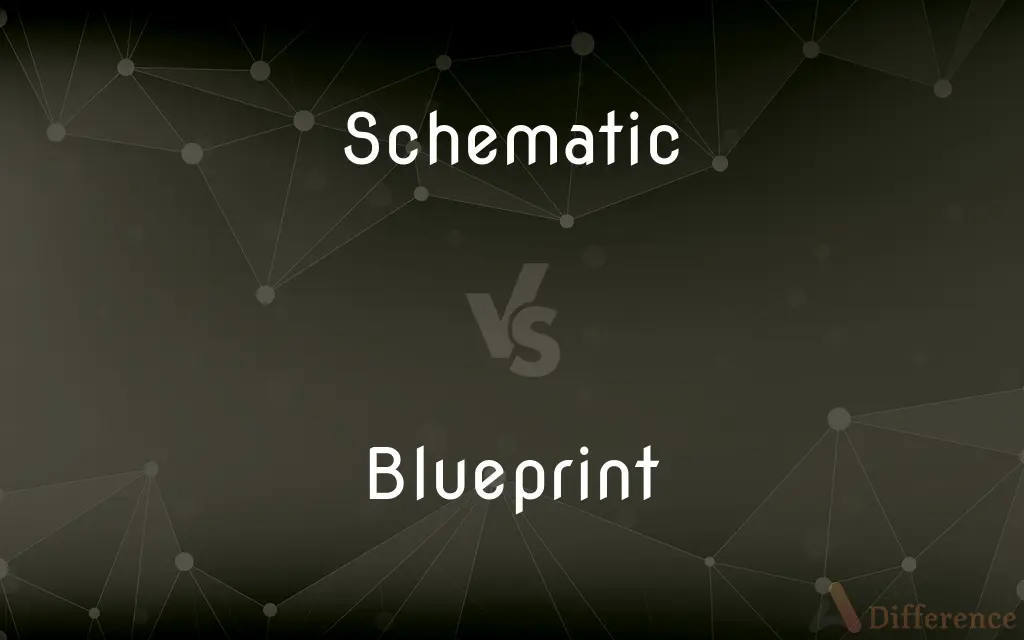Schematic vs. Blueprint — What's the Difference?
By Tayyaba Rehman — Updated on November 7, 2023
A schematic is an abstract diagram showing relationships, while a blueprint is a detailed technical drawing for construction.

Difference Between Schematic and Blueprint
Table of Contents
ADVERTISEMENT
Key Differences
A schematic is an abstract representation to demonstrate the relationship between different components within a system. It simplifies the layout without displaying the actual size or location of the components, focusing on how things work together conceptually. A blueprint, in contrast, is a detailed plan or technical drawing that represents the dimensions, construction, and materials required for building something. Blueprints are used to provide precise instructions for builders and architects.
Schematics are typically used in the field of electronics or mechanics to convey the design of a circuit or system. They use symbols to represent components and lines to show connections and relationships. This abstract approach allows for an understanding of the flow and operation without getting bogged down in the specifics of physical construction. Blueprints, however, are highly detailed and specific, often containing a series of drawings that include floor plans, elevations, and sections, giving a comprehensive view of what the finished product should look like.
In the creation of a product or structure, schematics serve as the initial step in the design process, where the functionality and relationships between components are mapped out. Blueprints come into play later, once the schematic design has been approved, to turn the conceptual into a constructible reality. While schematics are more about conceptualization, blueprints are the bridge to actual creation.
The users of schematics and blueprints differ as well. Engineers and designers often use schematics to develop and troubleshoot systems. Contractors, construction workers, and architects, on the other hand, rely on blueprints as a guide throughout the construction process. Schematics might be used to fix a piece of electronic equipment, while blueprints are used to erect a building or fabricate a machine.
Lastly, the tools and skills required to interpret these documents are quite different. Reading a schematic effectively requires an understanding of electrical theory and symbolic representations, whereas interpreting blueprints requires knowledge of building codes, architectural design principles, and construction techniques. Both schematics and blueprints are vital documents, but they serve different purposes and are used at different stages of the creation and building process.
ADVERTISEMENT
Comparison Chart
Purpose
Illustrates relationships and function.
Provides detailed construction plans.
Content
Uses symbols and lines.
Includes measurements and specifications.
Use Case
Designing and troubleshooting.
Construction and fabrication.
Users
Engineers and designers.
Builders and architects.
Detail Level
Abstract and conceptual.
Detailed and technical.
Compare with Definitions
Schematic
A schematic is a basic visual guide used in various fields to represent theoretical designs.
The chemistry student used a schematic to illustrate the molecular structure.
Blueprint
A blueprint is a plan that serves as a detailed model for future work.
The committee created a blueprint for the fundraising event.
Schematic
A schematic is a diagram that represents the elements of a system using abstract symbols.
The electrician followed the schematic to wire the new lighting system.
Blueprint
A blueprint is a comprehensive plan that acts as a roadmap for manufacturing or construction.
The engineer's blueprint for the new engine was approved for production.
Schematic
A schematic is a symbolic representation to aid in the understanding of how a system operates.
The schematic of the car's engine made troubleshooting much easier.
Blueprint
A blueprint is a technical drawing that lays out the design of a project with precise specifications.
Before construction began, the builders studied the building's blueprint carefully.
Schematic
A schematic is an abstract drawing used to describe the relationship between components within a system.
The pilot reviewed the aircraft's control system schematic before the flight.
Blueprint
A blueprint is a reproduction of a technical drawing or engineering drawing using a contact print process on light-sensitive sheets. Introduced by Sir John Herschel in 1842, the process allowed rapid and accurate production of an unlimited number of copies.
Schematic
A schematic, or schematic diagram, is a representation of the elements of a system using abstract, graphic symbols rather than realistic pictures. A schematic usually omits all details that are not relevant to the key information the schematic is intended to convey, and may include oversimplified elements in order to make this essential meaning easier to grasp.
Blueprint
A blueprint is a detailed architectural plan for building or construction.
The architect unrolled the blueprints for the new house on the table.
Schematic
Of, relating to, or in the form of a scheme or diagram.
Blueprint
A blueprint is a guide containing the necessary steps and materials for construction.
The bridge's blueprint outlined the exact dimensions and materials required.
Schematic
A structural or procedural diagram, especially of an electrical or mechanical system.
Blueprint
A contact print of a drawing or other image rendered as white lines on a blue background, especially such a print of an architectural plan or technical drawing. Also called cyanotype.
Schematic
Represented too simply or in an overly formulaic way, reflecting a shallow or incomplete understanding of complex subject matter
Blueprint
A mechanical drawing produced by any of various similar photographic processes, such as one that creates blue or black lines on a white background.
Schematic
Sketchy, incomplete
Blueprint
A detailed plan of action.
Schematic
Relating to a schema
Blueprint
A model or prototype.
Schematic
A simplified line drawing used by scientists, engineers, technologists and others to illustrate a system at an abstract level. Schematic drawings often use standard symbols for clarity.
I'll have to study the schematics for the new integrated circuit before I can create a good layout.
Blueprint
To make a blueprint of.
Schematic
Of or pertaining to a scheme or a schema.
Blueprint
To lay a plan for.
Schematic
Diagram of an electrical or mechanical system
Blueprint
A type of paper-based reproduction process producing white-on-blue images, used primarily for technical and architecture's drawings, now largely replaced by other technologies.
Schematic
Represented in simplified or symbolic form
Blueprint
A print produced with this process.
Schematic
A schematic is a simplified outline of a complex process or device.
She drew a schematic to explain the software's workflow.
Blueprint
A detailed technical drawing (now often in some electronically storable and transmissible form).
Blueprint
Any detailed plan, whether literal or figurative.
Blueprint
To make a blueprint for.
The architect blueprinted the renovation plan once the client had signed off.
Blueprint
To make a detailed operational plan for.
They blueprinted every aspect of the first phase of the operation.
Blueprint
See under Print.
Blueprint
Something intended as a guide for making something else;
A blueprint for a house
A pattern for a skirt
Blueprint
Photographic print of plans or technical drawings etc.
Blueprint
Make a blueprint of
Common Curiosities
When would you use a schematic?
You would use a schematic during the design phase to plan and troubleshoot systems.
Can a schematic show physical dimensions?
No, it typically shows relationships and operations, not exact sizes or distances.
What is a blueprint?
A blueprint is a detailed technical drawing used in construction that specifies design, dimensions, and materials.
What software is used for blueprints?
Blueprints are also created using CAD software, tailored for architectural design.
When is a blueprint used?
A blueprint is used during the construction phase as a guide for builders and architects.
What is a schematic?
A schematic is an abstract diagram showing the functional elements of a system and their relationships.
Can anyone draft a blueprint?
Drafting a blueprint typically requires specialized skills and knowledge in architecture or engineering.
Are schematics used in electronics?
Yes, they're commonly used to represent electronic circuits.
Can blueprints be used for products other than buildings?
Yes, blueprints can be created for any physical object requiring precise construction.
Do schematics require technical knowledge to read?
Yes, understanding schematics requires knowledge of the system and symbolic representations.
Are blueprints still blue?
Not necessarily; the term now refers to any detailed plan, regardless of color.
What software might be used to create schematics?
CAD (Computer-Aided Design) software is often used to create schematics.
Do schematics and blueprints serve the same final purpose?
No, schematics aid in understanding and designing a system, while blueprints are used for the actual creation of a project.
Do blueprints reflect the exact size and shape of components?
Yes, blueprints include precise measurements for construction purposes.
Is a schematic enough to build a structure?
No, a schematic is for conceptual understanding; blueprints are needed for actual construction.
Share Your Discovery

Previous Comparison
Strawberry vs. Raspberry
Next Comparison
Ethical vs. UnethicalAuthor Spotlight
Written by
Tayyaba RehmanTayyaba Rehman is a distinguished writer, currently serving as a primary contributor to askdifference.com. As a researcher in semantics and etymology, Tayyaba's passion for the complexity of languages and their distinctions has found a perfect home on the platform. Tayyaba delves into the intricacies of language, distinguishing between commonly confused words and phrases, thereby providing clarity for readers worldwide.














































